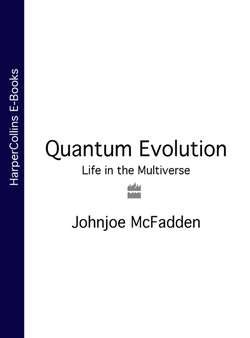Читать книгу Quantum Evolution: Life in the Multiverse - Johnjoe McFadden - Страница 26
WHEN DNA DOESN’T WORK
ОглавлениеThe job of the DNA replication machinery is to make a perfect copy of the parental DNA strand. However, no copying is perfect – think how a photocopy of an image degrades as it is repeatedly copied in a photocopying machine. The DNA copying machinery of living cells is capable of a much higher degree of fidelity than a photocopying machine, but occasionally it does insert the wrong base. These errors are mutations that may or may not lead to changes in the amino acid sequence of proteins. Mostly the changes are of little or no consequence. Occasionally, if a mutation interferes with the function of an essential protein, it can be severely harmful, even lethal. The human genetic disease thalassemia is caused mainly by a mutation that changes a single amino acid in one of the globin proteins of blood haemoglobin. Even more rarely, mutations may provide some advantage to their host. Natural selection tends to favour organisms carrying advantageous mutations that allow them to produce more offspring. Over millions of years, organisms will evolve by selection of mutant offspring which are fitter than their parents. Mutations are therefore the elusive source of the variation that Darwin needed to complete his theory of evolution. They provide the raw material for all evolutionary change.
But where do these mutations come from? They are mostly generated during DNA replication. The enzyme that constructs new DNA strands is called DNA polymerase. Its basic activity is to string together units of nucleotides (the units of DNA that carry the bases) to make new DNA strands. However, the enzyme doesn’t work unless it has a template on which to build the new strand. The old DNA strands are first unwound to allow DNA polymerase to slide along each strand (it forms a kind of doughnut structure around the DNA) to make the new strand. But occasionally (roughly one in every ten thousand bases) DNA polymerase makes a mistake and inserts the wrong base. The enzyme has several possible excuses for its errors. Radiation and some hazardous chemicals can cause mutations and do so by promoting errors during the DNA replication process. However, one source of replication error is unavoidable because it is due to the intrinsic quantum nature of the DNA code.
In What is Life? Erwin Schrödinger proposed that genes were aperiodic crystals (crystals lacking a periodic structure) and that quantum fluctuations may be a source of mutations. However, as he went along with the prevailing view that genes were made of protein, this suggestion was generally ignored when the true nature of the genetic code became known. The Swedish geneticist Per-Olov Löwdin from the University of Uppsala revived interest in the quantum nature of the genetic code by pointing out that it could be viewed as a linear array of protons. As described above, the coding properties of DNA are due to the hydrogen bonding between protons and electrons in the DNA bases: the position of these particles determines which hydrogen bonds can form and thereby the base-pairing underlying the genetic code. Protons and electrons are fundamental particles and their position is subject to quantum mechanics. The genetic code thus becomes a quantum code.
One of the peculiar features of quantum mechanics is that in most circumstances we cannot know exactly where a particle is: its position is uncertain (an aspect of Heisenberg’s famous uncertainty principle that will be examined in more detail later). This uncertainty is the basis for a phenomenon called quantum tunnelling, whereby protons are said to tunnel from one position to another. In fact quantum particles don’t really tunnel anywhere. It is just that the inevitable (Heisenberg) uncertainty in their position means that they materialize in places you wouldn’t normally expect them.
The coding protons in DNA can (and must) quantum tunnel within the DNA molecule. This leads to tautomeric structures for DNA bases, with coding protons tunnelling from one atom to another to form modified chemical structures. Tautomeric forms of DNA bases can pair with the incorrect base: A can pair with G and T with C (rather than A with T and C with G). Watson and Crick proposed that if, during DNA replication, either the template DNA base or the incoming base is in the tautomeric form, then the wrong base may be inserted into the new strand, resulting in a mutation. Tautomeric forms of DNA bases account for about 0.01 per cent of all natural DNA bases, so incorporation of incorrect bases, due to tautomerization, is likely to be relatively common. However, our DNA replication machinery has proofreading enzymes able to recognize incorrectly inserted bases and clip them out of the growing strand. The inclusion of proof-reading into the system vastly reduces the error rate to only about one wrong base for every billion correct bases. Those errors that escape the correction machinery are the source of naturally occurring mutations; and their source is quantum-mechanical.
Watson and Crick’s structure was therefore the culmination of centuries of biological progress. The great mysteries were laid bare: how biological information is encoded, how it is inherited and how it is changed. But it also pointed in quite a surprising direction, towards the involvement of that other great triumph of twentieth century science – quantum mechanics – in the fundamental basis of life and the driving force of evolution.
